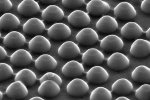Through an emerging branch of technology called plasmonics, the study of the interaction of light and metal, a team of Stanford researchers believe they can more effectively trap light within thin solar cells using a honeycomb “waffle” type approach.
In plasmonics, high-frequency, dense electrical waves are created instead of electron particles, travelling in extremely fast waves like sound through the air. The effect can only be created under precise circumstances.
In order to create the world’s first plasmonic dye-sensitized solar cell, Michael McGehee , associate professor of materials science and engineering at Stanford Univerity and his team applied titania, which a semi-porous metal also transparent to light, to a transparent, electrically conductive base.
Next, a honeycomb pattern of nanoscale dimples was created using equipment akin to a waffle iron, which consisted of tiny silicon nanodomes, each about 300 nanometers in diameter and 200 nanometers high. As a point of comparison, a human hair is about 60000 nanometers in diameter.
A light-sensitive dye was poured over the “waffle” material, creating a thin layer in the pores and dimples. A layer of silver was then applied; the end result being a pattern of tiny domes on the side of the silver that would face a light source.
The nanodomes help reflect unabsorbed light back into the dye for more efficient collection and light interacting with the silver nanodomes produces plasmonic effects. It’s an exact process, with the nanodomes needing to be a particular size and spacing to produce an optimal plasmonic reaction.
Professor McGehee says that by utilising plasmonics, light can be better absorbed in thinner solar cells than ever before.
Source/Image source







































